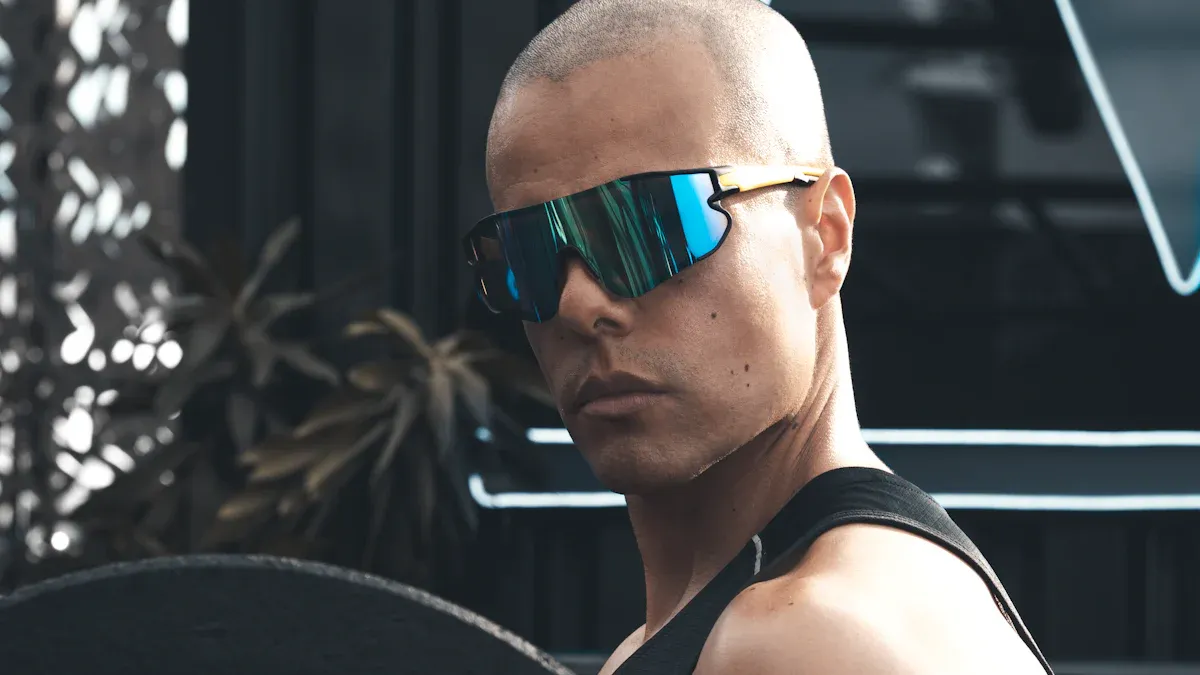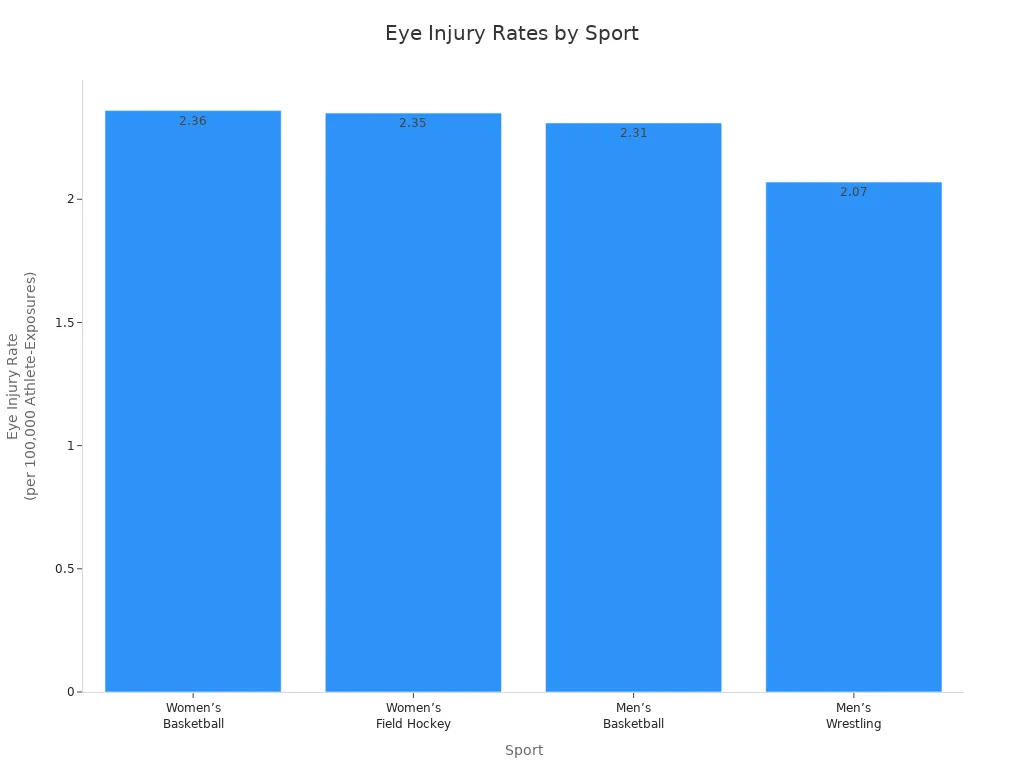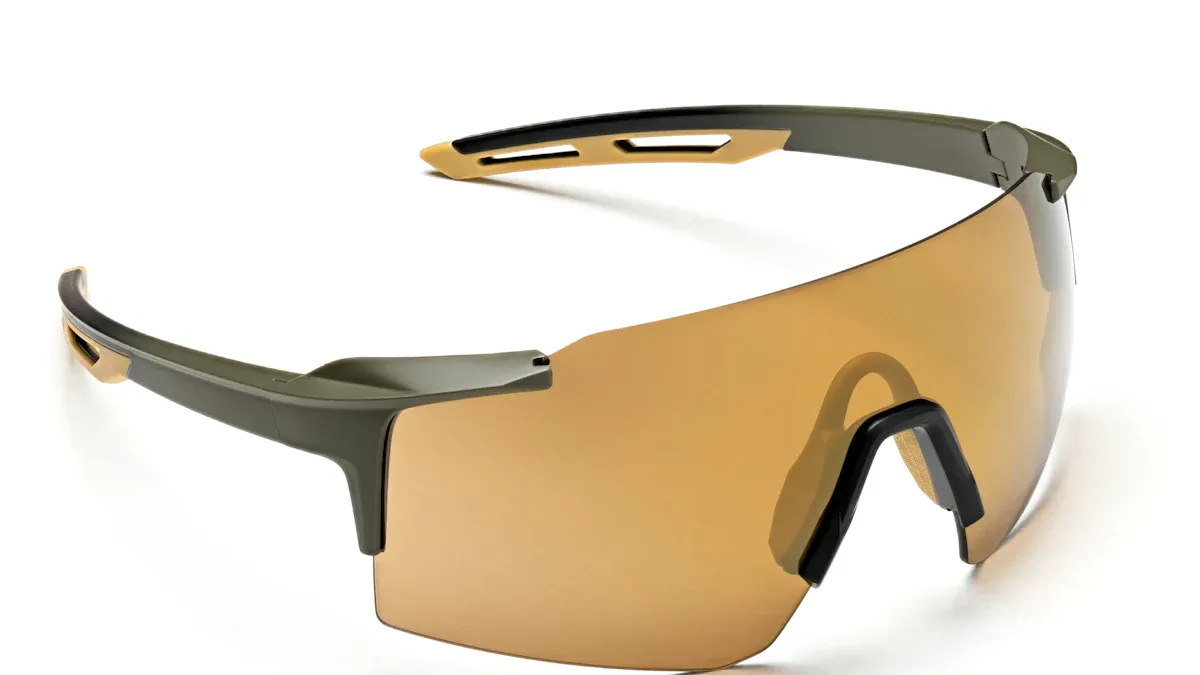T: +86-20-86973099
E: sales@xqglasses.com
E: sales@xqglasses.com
NO.3, Yongfu Road, Sandong Avenue West, Huadu District, Guangzhou City, Guangdong Province, China
Views: 0 Author: Site Editor Publish Time: 2025-07-28 Origin: Site









Choosing protective sports eyewear shows you care about safety. Impact-resistant materials and a good fit are important. Features made for your sport help a lot. Each year, over 33,000 Americans go to the emergency room for sports eye injuries. The right protective eyewear can stop up to 90 percent of these injuries. You need eyewear that fits well and stays in place. It should feel comfortable and protect your eyes. Sports glasses made for you help you focus on playing. You do not have to worry about getting hurt.
Pick sports eyewear with impact-resistant lenses and strong frames. These help protect your eyes from getting hurt.
Make sure your glasses fit well and feel comfortable. Look for non-slip nose pads and straps that you can adjust. These keep your glasses in place.
Choose lens coatings and tints that fit your sport and lighting. Try anti-fog, UV protection, or color tints for better sight.
Find eyewear that meets safety rules like ASTM F803 or ANSI Z87.1. This makes sure your eyes stay safe when you play.
If you need vision help, use prescription sports glasses or contacts. Wear them with protective eyewear for clear and safe vision.

You might not realize how common eye injuries are in sports. Every year, thousands of athletes end up in the emergency room because of accidents on the field or court. Most of these injuries happen when a ball, bat, or another player hits the eye. Sometimes, even a finger or piece of equipment can cause damage. Here are some of the most common causes of eye injuries in sports:
Blunt trauma from balls, elbows, or equipment
Penetrating injuries from broken glasses or flying debris
Scratches on the eye surface from fingernails or dirt
Damage from UV rays during outdoor sports
Chemical burns from powders or sprays used on fields
You can see that sports injury prevention starts with the right protection. In fact, about 90% of sports-related eye injuries are preventable if you wear protective sports eyewear. This is especially important for kids and teens, who make up a big part of these injuries. Some sports have higher risks than others. Take a look at this chart to see which sports have the most eye injuries:

Basketball, field hockey, and wrestling top the list. If you play these sports, you need to pay extra attention to eye protection.
Wearing sports eyewear does more than just stop injuries. It gives you safety and confidence every time you play. Protective eyewear absorbs and deflects impacts, so your eyes stay safe from fast-moving balls or accidental bumps. You also get UV protection, which shields your eyes from the sun’s harmful rays. This helps prevent long-term problems like cataracts.
You will notice other benefits, too:
Clear vision during games and practice
Less eye strain and fatigue, even after hours of play
Protection from dust, dirt, and glare
A boost in confidence and focus, knowing your eyes are safe
Protective eye equipment helps you stay in the game and enjoy your sport. You can focus on your performance, not on worrying about injuries. Vision protection for athletes is not just about today—it keeps your eyes healthy for years to come. When you choose the right sports eyewear, you make safety a part of your routine.

When you pick out sports eyewear, the lens material matters a lot for your safety and performance. You want lenses that can handle hard hits and keep your eyes safe. The two top choices are polycarbonate lenses and Trivex. Both are highly impact-resistant and meet strict safety standards like ANSI F803 and ANSI Z87.1. Polycarbonate lenses have been around since the 1960s. They were first used for astronaut helmets because of their strength. Now, they are the most common material for impact-resistant sports glasses in the USA. Trivex is newer and was made for military use. It is lighter than polycarbonate and gives you better optical clarity, which means you see things more sharply.
Here’s a quick comparison:
| Lens Material | Impact Resistance | Safety Ratings | UV Protection | Optical Clarity | Weight | Cost | Best For |
|---|---|---|---|---|---|---|---|
| Polycarbonate | Very high | ANSI F803, Z87.1 | 100% | Good | Slightly heavier | More affordable | Full-rim frames |
| Trivex | High | ANSI F803, Z87.1 | 100%+ | Excellent | Lighter | More expensive | Rimless/semi-rimless frames |
Both materials block 100% of UV rays, so you get strong uv protection. Polycarbonate is usually more affordable and reliable for most sports. Trivex is a great pick if you want lighter glasses and the sharpest vision, especially with rimless frames. No matter which you choose, always look for high-quality sports eyewear with lenses that meet safety standards. This gives you elite protection and performance on the field.
The frame of your sports eyewear needs to be tough and flexible. You want frames that can bend without breaking and bounce back after a hit. TR90 is a popular thermoplastic material for high-quality sports eyewear. It is lightweight, flexible, and resists impacts. Nylon frames are also common. They are strong, flexible, and can handle rough play. Some frames use special thermoplastics like Gliamides or Grilamid®. These materials keep their shape in heat, cold, and even when exposed to chemicals.
Wraparound frames are a smart choice for extra protection. They curve around your face and cover your eyes from all sides. This design blocks wind, dust, and debris. It also keeps harmful UV rays away from your eyes and skin. Wraparound frames help you keep a wide field of vision, so you never miss the action. They grip your head securely, so your glasses stay put even when you move fast.
Tip: Choose frames made from TR90 or nylon for the best mix of durability, flexibility, and comfort. Wraparound styles give you more coverage and safety.
A good fit is just as important as strong materials. If your sports eyewear slips or pinches, you will get distracted. Look for features that keep your glasses in place, even when you sweat or move quickly. Non-slip nose pads and temple grips made from silicone or rubber help your eyewear stay put. Adjustable straps add extra security, which is great for kids or when you play on rough ground.
You want your glasses to feel light on your face. Lightweight frames prevent headaches and red marks, even after hours of play. Adjustable nose pads and temples let you customize the fit. This makes your eyewear feel like it was made just for you. When your glasses fit well, you can focus on your game and enjoy optimal visibility.
Non-slip nose pads and temples keep glasses stable
Adjustable straps and temples help you get the right fit
Lightweight frames add comfort for long games
Personalized fitting reduces distractions
Lens coatings and tints make a big difference in how well you see and how protected your eyes stay. Anti-fog coatings stop your lenses from steaming up, which is a big help during intense games or when you move between hot and cold places. Hydrophobic coatings repel water, so sweat and rain roll right off. This keeps your vision clear in all weather.
You can also pick lens tints that match your sport and lighting. Gray lenses work well on sunny days and keep colors true. Brown or amber lenses boost contrast and depth, which helps in golf or cycling. Yellow or gold lenses brighten things up in low light or indoors. Green lenses balance glare and color, making them good for mixed light. Blue or purple lenses cut glare from water or snow, perfect for skiing or boating. Red or orange lenses help you see better in cloudy or snowy weather.
Lens Tint | Best For | Lighting Conditions |
|---|---|---|
Gray | Outdoor sports, driving | Bright sunlight |
Brown/Amber | Golf, cycling, hiking | Partly cloudy, sunny |
Yellow/Gold | Indoor sports, shooting | Low light, overcast |
Green | Baseball, golf | Mixed light |
Blue/Purple | Water sports, skiing, snowboarding | Bright, reflective surfaces |
Red/Orange | Water sports, cloudy days | Moderate to low light |
Anti-scratch coatings protect your lenses from damage, so you keep clear vision longer. UV-protected lenses shield your eyes from harmful rays, lowering your risk of eye diseases like cataracts. These features help you get the most out of your high-performance sports eyewear, giving you both protection and clear sight.
Note: Always choose impact-resistant material and coatings that match your sport and environment. This way, you get the best safety, protection, and visibility every time you play.
When you pick out sports safety glasses, you want to know they can really protect your eyes. That’s where safety standards come in. Two of the most important are ASTM F803 and ANSI Z87.1. ASTM F803 is the strictest standard for sports eyewear. It tests glasses to make sure they can handle high-speed impacts, like a ball flying at 90 mph. This standard also checks that the lenses stay locked in place, even if you get hit hard during basketball, tennis, or soccer. Every year, over 600,000 people in the U.S. get sports-related eye injuries. Most of these could be prevented with eyewear that meets ASTM F803.
ANSI Z87.1 is another key standard. It’s used for workplace safety glasses, but you’ll see it on some sports eyewear too. This standard checks if glasses can survive a steel ball dropped from 50 inches. If you see Z87+ on your glasses, it means they passed even tougher impact tests. Here’s a quick look at how these standards compare:
Aspect | ASTM F803 (Sports Eyewear) | ANSI Z87.1 (Workplace Eyewear) |
|---|---|---|
Main Use | Sports safety glasses for high-speed impacts | Safety glasses for work hazards |
Impact Test | Projectiles up to 90 mph | Ball drop and high-velocity tests |
Extra Features | Lens locking, side protection | Chemical, dust, and heat protection |
Always check for these standards when you shop for sports safety glasses. They help you trust that your eyewear will give you the protection you need.
Not every sport has the same risks. You need to match your eyewear to your activity. In high-risk sports like basketball or racquetball, you face fast balls and flying elbows. For these, choose goggles with padding and secure straps. These features keep your glasses in place and add extra safety.
For non-contact sports, you still need protection, but the focus changes. Outdoor sports like cycling or baseball need sunglasses with 100% UV protection and polarized lenses to cut glare. Wraparound frames help block wind and dust. If you swim, pick goggles that keep out chemicals and germs.
Here’s a quick guide to help you choose:
Contact Sports: Goggles with padding, straps, and impact-resistant polycarbonate lenses.
Outdoor Sports: Sunglasses with UV protection, polarized or photochromic lenses, and wraparound frames.
Indoor Sports: Clear or yellow lenses for better contrast, anti-fog coatings, and lightweight frames.
Swimming: Watertight goggles for chemical and infection protection.
Tip: Prescription sports safety glasses are available if you need vision correction. You don’t have to choose between clear sight and safety.
Pick the right eyewear for your sport, and you’ll play with confidence, knowing your eyes have the best protection.
If you wear glasses, you do not have to give up on sports. You have several ways to get clear vision and keep your eyes safe. Sports eyewear can be made with your exact prescription. You can choose from three main options:
Direct Glazing: Your prescription lenses go right into the sports frame. This gives you a wide field of view and a smooth look.
Clip-in Lenses: Your prescription lenses clip inside the sports glasses. You can swap them out if you need to change lenses for different sports or lighting.
Adapter Solution: Your prescription lenses fit into an adapter that sits inside the frame. This works well for shield-style glasses and lets you use contact lenses if you want.
These choices help you get the best fit for your eyes and your sport. Prescription sports goggles fit tightly around your eyes and use a strap to stay put. They work well for high-impact sports and with helmets. Prescription sports glasses look more like regular glasses but have curved frames, strong materials, and straps to keep them from slipping. Both types use tough polycarbonate lenses and flexible frames. Regular glasses do not offer this level of safety. They can break or fall off during play. Prescription safety glasses meet strict standards and help you play your best while protecting your eyes.
Tip: Youth models come with extra padding and adjustable straps for comfort and safety.
You have other ways to see clearly during sports. Contact lenses are a popular choice. They give you a wide, clear view and do not fog up. Contacts move with your eyes, so you get steady vision. They do not break or fall off, and you can wear them with helmets or goggles. Some contacts even come tinted to cut glare and boost contrast for sports like tennis or baseball.
Other options include RX inserts or adapters that snap behind non-prescription lenses. These work well if you want to switch between different sports or lighting. Some athletes with mild vision needs play without correction. For swimming or diving, you can get custom lenses glued into masks or use premade lenses for simple fixes.
Option | Pros | Cons |
|---|---|---|
Contact Lenses | Wide view, no fog, safe with helmets | Need care, risk of irritation |
RX Inserts/Adapters | Flexible, cost-effective | May fog, less side vision |
No Correction | Simple, no gear needed | Not for strong prescriptions |
Custom Swim Lenses | Clear vision in water | Higher cost, longer wait |
You can pick what works best for your eyes and your sport. Prescription safety glasses and other options help you stay safe and see clearly, so you can focus on the game.
Choosing protective sports eyewear keeps you safe from eye injuries and helps you play your best.
Here are the key steps to follow:
Pick eyewear designed for your sport and vision needs.
Use impact-resistant lenses and sturdy frames for strong protection.
Make sure your glasses fit snugly and feel comfortable.
Check for features that boost visual clarity, like anti-fog and UV protection.
Replace eyewear if you see any damage or wear.
Remember, regular checkups with an eye care professional help you avoid eye injuries and keep your eyes healthy.
Sports eyewear uses impact-resistant lenses and tough frames. You get better protection from hits, falls, and flying objects. Regular glasses can break easily and may not stay on your face during play.
You can wear contacts, but they do not protect your eyes from injury. You still need sports goggles or glasses for safety. Contacts help you see clearly, but they do not block impacts or flying debris.
Your glasses should feel snug but not tight. They should not slip when you move or sweat. Try shaking your head or jumping. If your eyewear stays in place, you have a good fit.
Yes, you do. Outdoor sports need UV protection and sometimes tinted lenses. Indoor sports work best with clear or yellow lenses for better contrast. Pick eyewear that matches your sport and lighting.
Check your eyewear for scratches, cracks, or loose parts. Replace them if you see any damage. Most people need new sports glasses every one to two years, or sooner if you play often.